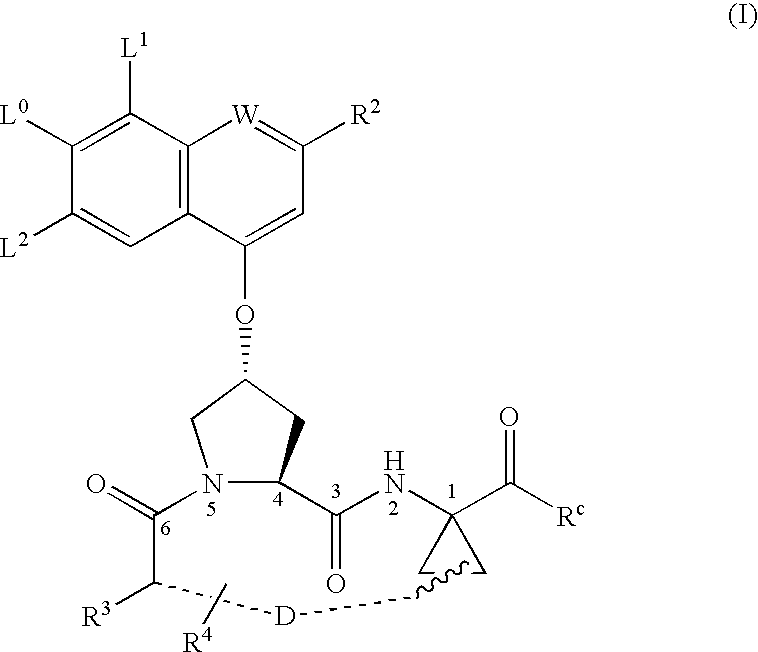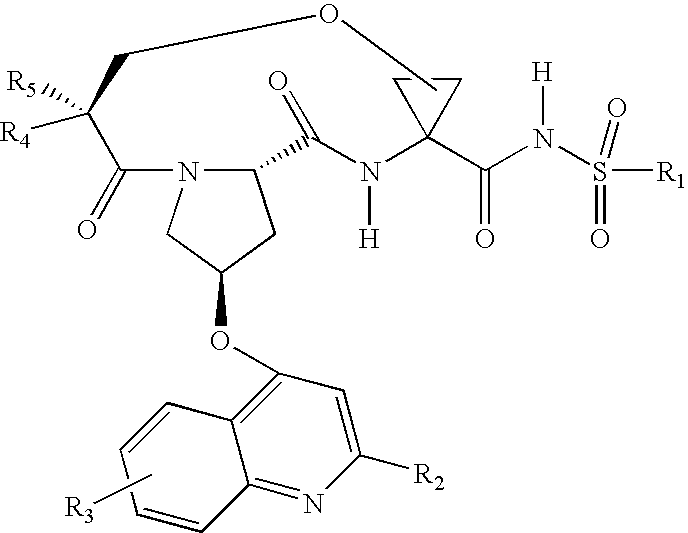Macrocyclic peptides active against the hepatitis C virus
a peptide and macrocyclic technology, applied in the field of compound, can solve the problems of lack of effective immunoglobulin treatment, lack of cellular and humoral immune responses in protecting against hcv infection and disease, and the recommendation of immunoglobulin treatment, so as to achieve the effect of treating or preventing a hepatitis c viral infection
- Summary
- Abstract
- Description
- Claims
- Application Information
AI Technical Summary
Benefits of technology
Problems solved by technology
Method used
Image
Examples
example 1
Synthesis of INRF12 Brosylate Intermediate
Step 1: Introduction of the Boc-protectinq group: Synthesis of INRF2
The amino-protection was done with the Boc-protecting group. INRF 1 (trans-4-hydroxy L-proline) (249.8 g, 1.905 mol) was dissolved in water (375 mL) and 45% sodium hydroxide solution (203 g, 2.286 mol). To ensure good phase transfer, tert-butanol (106 g) was added. In a different procedure, acetone was used instead of THF / tert-butanol. The reaction mixture was heated to 50° C. and the anhydride Boc2O (424 g, 1.943 mol) was dissolved in THF (425 mL, or acetone) is slowly added. The reaction is exothermic and generates gas (CO2) as the Boc2O was added. If the reaction does not proceed as wanted, catalytic amounts of DMAP (2.3 g, 19 mmol) can be added. After the addition of the Boc2O, the reaction mixture is kept 0.5-1 h at 50° C., and the THF was removed by partial distillation. The pH of the remaining solution was adjusted to about pH3 with concentrated HCl (204 g, 2.076...
example 2a
Synthesis of 2-carbomethoxy-4-hydroxy-7-methoxy8-methylquinoline (A5)
Step A
To a solution of 2-methyl-3-nitro anisole A1 (5.1 g; 30.33 mmol; requires ˜30 min to dissolve) in absolute ethanol (85 mL) was added 10% Pd / C catalyst (500 mg). The solution was hydrogenated under a hydrogen filled balloon at atmospheric pressure and room temperature for 19 h. The reaction mixture was filtered through a Celite pad, rinsed and evaporated to dryness to obtain 2-methyl-3-methoxyaniline A2 as a deep mauve oil (4.1 g; 29.81 mmol; 98% yield).
MS 137 (MH)+. Reverse Phase HPLC Homogeneity @ 220 nm (0.06% TFA; CH3CN H2O): 99%.
Step B
Dimethyl acetylene dicarboxylate A3 (3.6 mL, 29.28 mmol) was added dropwise to a solution of 2-methyl-3-methoxyaniline A2 (3.95 g, 28.79 mmol) in MeOH (100 mL) (reaction is exothermic). The mixture was heated at a gentle reflux for 5 hours cooled and concentrated under vacuum. The crude material was purified by flash column chromatography on silica gel with hexan...
example 2b
Synthesis of 2-carbomethoxy-8-bromo-4-hydroxy-7-methoxyquinoline (B6)
Step A 2-Amino-3-nitrophenol B1 (5 g; 32.4 mmol) was dissolved in H2O (29.5 mL) and 1,4-dioxane (14.7 mL). The mixture was heated to reflux and hydrobromic acid (48%; 16.7 mL; 147 mmol) was added dropwise over a period of 20 min. Upon completion of the addition, the reflux was maintained an additional 15 min. The reaction was cooled to 0° C. (ice bath), and sodium nitrite (2.23 g; 32.3 mmol) in H2O (20 mL) was added over a period of 30 min. The stirring was continued for 15 min at 0° C., then the mixture was transferred to a jacketed dropping funnel (0° C.) and added dropwise to a stirred mixture of Cu(I)Br (5.34 g; 37.2 mmol) in H2O (29.5 mL) and HBr (48%; 16.7 mL; 147 mmol) at 0° C. The reaction was stirred for 15 min at 0° C., warmed to 60° C., stirred for an additional 15 min, cooled to room temperature, and left to stir overnight. The reaction mixture was transferred to a separatory funnel and extracted with...
PUM
| Property | Measurement | Unit |
|---|---|---|
| Fraction | aaaaa | aaaaa |
| Composition | aaaaa | aaaaa |
| Antimicrobial properties | aaaaa | aaaaa |
Abstract
Description
Claims
Application Information
 Login to View More
Login to View More - R&D
- Intellectual Property
- Life Sciences
- Materials
- Tech Scout
- Unparalleled Data Quality
- Higher Quality Content
- 60% Fewer Hallucinations
Browse by: Latest US Patents, China's latest patents, Technical Efficacy Thesaurus, Application Domain, Technology Topic, Popular Technical Reports.
© 2025 PatSnap. All rights reserved.Legal|Privacy policy|Modern Slavery Act Transparency Statement|Sitemap|About US| Contact US: help@patsnap.com



